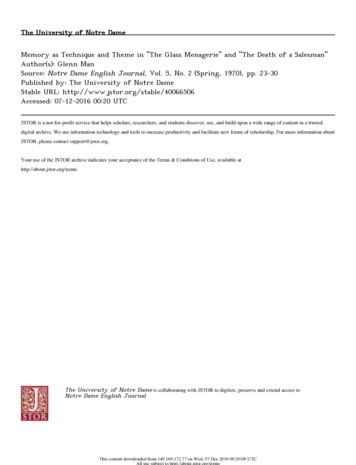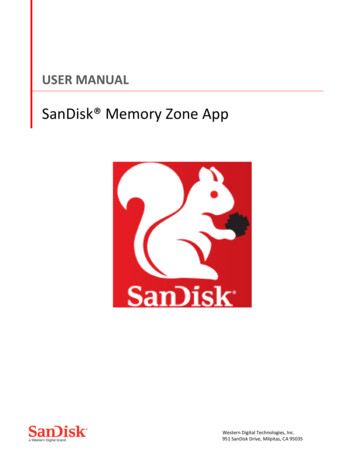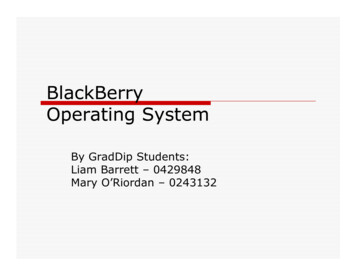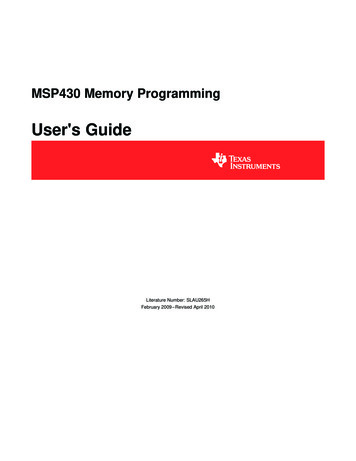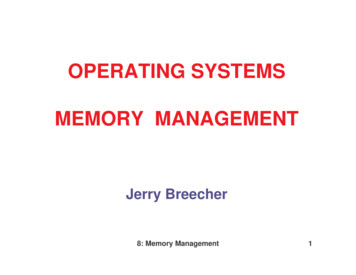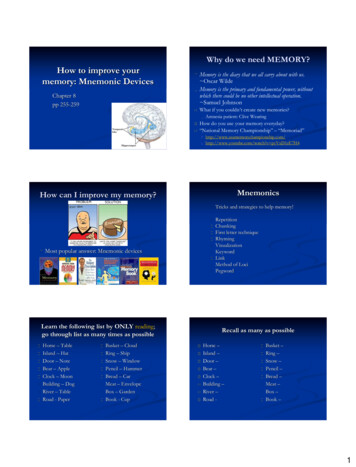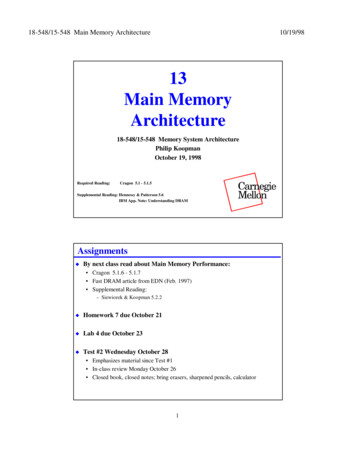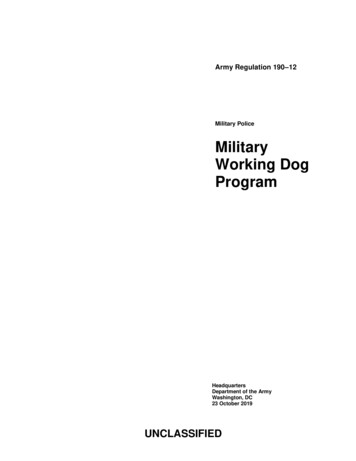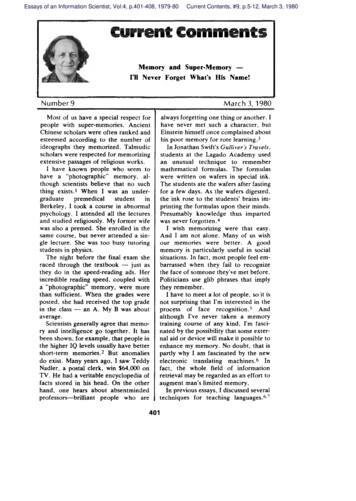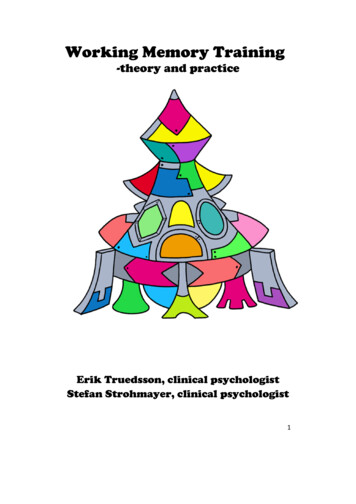
Transcription
Working Memory Training-theory and practiceErik Truedsson, clinical psychologistStefan Strohmayer, clinical psychologist1
CONTENTSPreface . 3Theory . 5Memory . 5Different types of memory . 6Working Memory . 8Model for working memory . 9Development and connections to other abilities . 15Measuring working memory capacity . 22Improving working memory . 26Who can benefit from training? . 28Interventions for working memory deficits . 36Research and experiences of working memory training . 39Practice . 43To train working memory . 43Children . 47Adult . 51Evaluation . 53Case descriptions . 57Case description 1: Jacob, 7 years . 57Case description 2: Maria, 38 years . 66Bibliography . 74Appendices . 772
PREFACEWorking memory training has become a common practice in many schoolsand homes during the last few years. Since 2006 we have been given theopportunity to present a long series of lectures, conferences and trainingcourses for, among others, teachers, psychiatrists, psychologists, specialeducation teachers and parents of children with concentration difficulties.The interest in working memory training seems to continue to grow, while atthe same time, more and more research is being carried out in the field. Inrecent years it has been demonstrated that working memory training canhave a positive impact on a number of areas. Some examples includeimproved concentration ability, impulse control and arithmetic skills inchildren with ADHD, increased working memory capacity in children withpoor working memory and strengthened problem solving ability in adults.Much research remains to be done and within a few years, hopefully morewill be known on the benefits of working memory training.This book is intended for those who have an interest in working memorytraining. It can be used as a complement to the computer software MemoryQuest for those who are going to coach a child or an adult or if you are aboutto train on your own. Furthermore, this book also serves as an independentsource of information on working memory and working memory training.The book consists of two main parts. In the first part we describe thememory system in general and then give a more detailed description ofworking memory. Among other things, we describe how working memorycapacity can be measured, how it is connected to school achievement andcognitive functions, and how working memory can be trained. We thendescribe two target groups who can benefit from working memory training:children and adults with ADHD as well as those with poor working memory.Finally, we give an overview of research and evaluations made on workingmemory training.3
The second part of the book is primarily aimed at those who are going tocoach a child or an adult who is going to train their working memory. Thissection provides information about things to consider before training, duringtraining, and after training. It includes practical tips and materials that can beused in connection with the training. It also gives our thoughts on howmotivation can be maintained during the whole training period and what isimportant to consider when evaluating the training. Finally, we present casedescriptions to demonstrate how working memory training can beconducted in practice.Stockholm, 12th of August 2010Stefan Strohmayer & Erik Truedsson4
THEORYINTRODUCTIONFrom birth and throughout life, we are constantly dependent of our memory.In almost all human activity a memory function is involved: when we readthe newspaper in the morning, when we drive our car to work, when wesolve a task together with our colleagues, or when we watch TV in theevening. Without functioning memory, many everyday activities becomeoverwhelming.MEMORYIn our daily lives, we are constantly exposed to information that is firstprocessed by our sensory systems, such as hearing and sight. A small part ofthe information we receive falls into our consciousness and is managed byour working memory. Of the information that we process in our workingmemory only a fraction will, in turn, be stored in our long-term memory as aresult of deeper processing.FIGURE 1: MEMORY - FROM INCOMING INFORMATION TO ENCODINGRepetitionSight, hearing,taste, rking MemoryRecallEncodingIncominginformationLong-term Memory5
DIFFERENT TYPES OF MEMORYSENSORY MEMORYIn our sensory memory we store incoming information from our senses for avery short time. All new information will first pass through our sensorymemory before it is transferred to other parts of our memory system. Thesensory memory consists of different types of sensory registers that handleinformation from our various senses such as hearing, sight and touch.WORKING MEMORYWe need working memory to maintain, process and use information in “realtime”. It is also a necessary component in order for us to learn new skills. Acharacteristic feature of working memory is that its capacity is limited.Working memory will be described in more detail later in the book.LONG-TERM MEMORYOur long-term memory can store a very large amount of information over along period of time, sometimes for life. A common view is that informationpasses through working memory before storage in long term memory.Long-term memory is usually divided into two sub-categories: declarativememory and non-declarative memory. Declarative memory is primarilyinformation that we can put into words and can in turn also be divided intotwo types: semantic memory and episodic memory. In the semantic memorywe store general knowledge, for example names of capital cities, as well asinformation about the meaning of various words; it is therefore closelyrelated to learning. In the episodic memory we store information about ourpersonal experiences and it often answers the questions where, when, andhow? For example: Where was my vacation last year? When did my cousinget married? How did we celebrate my eighteenth birthday?6
Non-declarative memory involves experiences we intuitively find difficult toput into words and can be divided into two types: procedural memory andperceptual memory. Procedural memory is the memory of how we carry outvarious practical activities. Knowledge about how we ride a bike or drive acar are examples of information stored in procedural memory. Perceptualmemory is our memory for different types of sensory experiences forexample how a strawberry tastes or how corduroy feels to touch.FIGURE 2: AN OVERVIEW OF THE MEMORY ualmemory7
WORKING MEMORYThe term working memory was first introduced in the 1960s. Before that theterm short-term memory that was used instead, which is our capacity tokeep information in memory over a short period of time. With the termworking memory the description of this memory system changed from beingonly a passive maintenance of information to also include active processingand manipulation of information. Working memory concerns our ability tohold, process and use information in real time.This capacity is extremely limited, which, among others, the Americanresearcher George Miller noticed. In his experiments in the 1950s he sawthat there was a clear limit to the number of objects that test personsgenerally managed to repeat when he presented word sequences to them.More recent research has also shown that there is a large variation inworking memory capacity between individuals, and that this variation oftenis an important factor for understanding the differences in intelligence,problem solving ability and reading comprehension between individuals.We use our working memory on a daily basis in a variety of situations. Evenbefore you leave home to go to work in the morning, you use your workingmemory. An example is when you pack your bag for a holiday. This involvesworking memory to a high degree because you need to keep in mind whatyou will be doing during the holiday and what you need for the differentactivities. To what extent you bring with you the right things for your holidaytherefore depends largely on your working memory capacity. If your workingmemory is overloaded there is a great risk that you might forget importantthings. To reduce the load on working memory you can use strategies suchas the one described below.Suggestion!An example of how you, in such situations, can help your workingmemory is to use a paper and pen. This way you can hold a part of theinformation outside yourself so that you do not need to haveeverything in your head. This is particularly appropriate for days whenyou are stressed or have slept too little, because these are factors thatwe know affect our working memory ability negatively.8
MODEL FOR WORKING MEMORYWorking memory has been studied from a variety of perspectives such asbiological (cells, genes), psychological (cognitive development) andpedagogical (behaviour in the classroom). As a result there are definitions ofwhat working memory is, and the focus and content of these descriptionsoften reflect the specific fields from which they have evolved. However, acommon denominator for most definitions of working memory is that it isviewed as a temporary system to maintain and manipulate information andthat it has a limited capacity.The researchers Alan Baddeley and Graham Hitch presented a model forworking memory that is still the most commonly used. In this book, we willuse Baddeley’s model to describe working memory in more detail.Baddeley’s model of working memory is called the multi component modelbecause it is composed of multiple processes (components) that interactwith each other. The current model consists of four parts: the phonologicalloop, the visuospatial sketchpad, the episodic buffer and the centralexecutive (see Figure 3). Studies over the past three decades have providedempirical support for the components of working memory in Baddeley’smodel.FIGURE 3: BADDELEY’S MODEL OF WORKING MEMORYCentral executiveVisuospatialsketchpadEpisodic bufferPhonologicalloopWorking memory’s four interacting parts9
THE PHONOLOGICAL LOOPThe phonological loop manages auditory information. Here we handle notjust information that we collect with hearing, but also impressions that wetake in via other senses and convert to phonological code. The phonologicalloop consists of two parts. Firstly, a passive storage where the informationwill be held only a few seconds and then disappear. Information that hasbeen lost from the passive storage, or the inner ear that it is also sometimescalled, cannot be retrieved. In order to retain information submitted to theinner ear over a longer period of time, it is necessary that the phonologicalloop's second part, the articulatory system, is activated.The articulatory system serves several purposes. It uses an inner voice toretrieve information from the passive storage, repeats it quietly and thenreturns it to the passive storage in order to be able to retain the informationover a longer period of time. This, thus, becomes a loop that retrieves theauditory information and then returns it. This function is called thearticulatory loop (see Figure 4).The articulatory system also converts visual impressions to phonologicalcode by using the inner voice to give names to the visual impressions. Anexample of this is that when we are shown a digit code on a piece of paperthat we must remember we often (automatically) choose to repeat the digits"quietly in our head" to remember them better.FIGURE 4: THE ARTICULATORY SYSTEMIncoming auditoryinformationPassive storageOther incominginformation (e.g.visual or spatial)Conversion tophonologicalcodeInner voice: Quietrepetition ofinformation10
There is support from several studies that the phonological loop provides anaccurate description of how memory actually works when we handleauditory information. It has been shown that it is easier to remember wordswhich sound different than words that sound similar. If we try to recall aseries of words that sound similar, the likelihood that we will rememberwrong significantly increases, because we are more likely to mix up similarwords. It is therefore more difficult to remember the series "blue, canoe,clue, shampoo, shoe" than the series "cat, yellow, kangaroo, house, soap".This is called the phonological similarity effect.It has also been shown that it is more difficult to remember sequences ofwords with many syllables than series of monosyllabic words; it is thereforemore difficult to remember the series “catamaran, rhinoceros, crocodile,lighthouse, telescope" than the series "dog, boat, salt, bat, screen". This iscalled the word-length effect. This effect is believed to be due to the factthat it takes longer for us to repeat long words and that we lose informationalong the way before we manage to repeat all words in a sequence of wordswith many syllables. This means that the number of items you can rememberon verbal working memory tests is dependent of what language you speak.For example, it has been shown that Welsh children can repeat fewer digitsthan English-speaking children because lists of digits take longer to articulatein Welsh.The amount of information we can keep in the phonological loop is alsoconnected to our speech rate; that is, individuals with a strong verbalworking memory often have a higher speech rate (measured inwords/second) than individuals with weak verbal working memory. Thisdepends on the fact that the speed of our spoken voice is approximately thesame as for our “inner voice" (which we use to maintain information).An example of when the phonological loop is used is when you are trying toremember an entry code that someone has told you. Imagine that you are intown and bump into a friend. You decide to meet at his friend’s home for asnack an hour later. You have forgotten your mobile and neither you noryour friend has pen or paper. You are on the way to work, one block away,where you have access to pen and paper. Your friend says her entry code toyou: "18 24" and you part ways. To remember the entry code while you walkto work you will repeat the digits in your head with your inner voice. Whenyou then arrive at work, you have succeeded in retaining the information inyour memory and can write it down.11
THE VISUOSPATIAL SKETCHPADThe visuospatial sketchpad handles visual and spatial information. Just like inthe phonological loop different types of impressions are processed in thesketchpad, but here they are transformed into visual impressions or spatialcode. The visuospatial sketchpad is also necessary for our ability to createand manipulate mental images. The sketchpad can be divided into two parts:a visual part that takes care of information about objects shapes and coloursand a spatial part that manages information about movement and direction.To measure visuospatial working memory, tests in which visual sequencesare to be encoded are often used. An example of this is to present blockpatterns that become more and more complex and within which positionsfor more and more blocks are to be memorized (see Figure 5).FIGURE 5: EXAMPLE OF BLOCK PATTERNExercise 2Exercise 1Try to memorizethe pattern.Reproduce thepattern fromyour memory bymarking thecorrect boxes.Try to memorizethe pattern.Reproduce thepattern fromyour memory bymarking thecorrect boxes.DdAn example of when you use the visuospatial system is when you need toremember directions of how to get somewhere. Imagine that you are outwalking in town when a friend calls. She wants to meet you in the newshopping mall. You do not know where it is but she describes it for you. Sheknows where you are now and explains exactly which way you go in order toget to the mall.12
She says – “first you go straight forward. At the convenience store turn left.Then you go past a toy shop and turn right. When you turn the corner youwill see the shopping mall.” In order to remember how you will find your wayyou must maintain the description in your head. You must remember whichplaces you will pass (convenience store, toy shop). Moreover, you mustremember in which direction you must go at the different places (straight,left, right).Another example of when the visuospatial system will be used is when youvisualize in your mind how the pieces on a chess board would probably bemoved over a number of moves ahead as a result of your intended nextmove.THE EPISODIC BUFFERThe episodic buffer is the latest addition to Baddeley's working memorymodel. It was added after research revealed that information from long-termmemory can have a profound effect on our working memory capacity. Theepisodic buffer is a temporary storage, where information from the incomingimpressions, the phonological loop and the visuospatial sketch pad areintegrated with information from long-term memory. The episodic buffer isconsidered important for learning because it can use multimodal code tointegrate information from different systems into a single representation.Like the other components of working memory, there is a limitation in theamount of information that can be handled simultaneously.An example of when you use the episodic buffer is when you solve amathematical problem. In order to calculate five times seven you use theinformation presented to you, but you must also use information from longterm memory, (the rules for multiplication) in order to calculate the answer.THE CENTRAL EXECUTIVEThe central executive, or the executive system as it is also called, coordinatesand monitors the other systems in working memory. In addition, severalaspects of how we use our attention are guided by the executive system.Firstly, the executive system determines our ability to focus attention andour ability to close out impressions that compete for our attention. Whenyou sit at home and watch your favourite programmes you direct yourattention to the television screen in front of you. At the same time, you close13
out the impressions of your surroundings such as children playing in the nextroom or a bird chirping outside the window. This puts the executive systemto work.The executive system also controls our ability to divide attention betweenseveral tasks simultaneously. An example of when high demands are put onthe executive system is if you correct a test while at the same time listeningto the news. The executive system is activated even when an automaticmental process is disturbed or fails.In order for us to make sense of larger amounts of information it is essentialthat part of the information can be handled automatically, i.e. withoutconscious mental effort. This is because the executive system must be ableto devote resources to higher mental processes such as problem solving andreasoning. For example, if you are an adult, reading is an automatic processwhich means that while you read there are mental resources left to reflecton the meaning of what you have read. In contrast for a child, reading maybe such a mentally-demanding activity that hardly any capacity is left tointerpret and take meaning from the text.The executive system is the part of working memory upon which there hasbeen the least research. From currently available research it seems theexecutive system serves the functions mentioned above. However, it isprobable that there are additional purposes not yet described.14
DEVELOPMENT AND CONNECTIONS TO OTHER ABILITIESDEVELOPMENT OF WORKING MEMORYWorking memory develops mostly between the ages of 5 and 11 years. Afour-year-old has a relatively undeveloped working memory and can repeatan average of about three digits that have been read aloud. A twelve-yearold can reproduce on average about six digits, i.e. twice as many. Until about15 years of age somewhat smaller but still significant improvements inworking memory occur. A fifteen-year-old approaches an adult s workingmemory capacity and can remember on average about seven digits. Theincrease in working memory capacity during childhood is believed to derivefrom improved basic skills such as processing speed and controlled attention,in addition to increased use of strategies such as repetition and Chunking(see section on next page).Working memory capacity reaches its peak when we are around 26 years ofage after which it slowly starts to diminish. However, it is only approximatelyaround the age of 60 that working memory capacity is significantly impaired.There are a number of theories about how it is that working memorydeteriorates with age. A partial explanation that has been identified is thatthe elderly appear to have more difficulties with preventing irrelevantinformation from long-term memory that is activated when working memoryis used to solve a challenging task. For the vast majority the decrease inworking memory capacity that age entails is not a major concern; with helpfrom various strategies learnt during our lives, our memory is still, in mostcases, sufficient. Deficiencies in working memory capacity can, however, be amore salient barrier with change of environment because information fromlong-term memory cannot be used for support to the same extent in newenvironments.VARIATION IN WORKING MEMORY CAPACITYAn important aspect of working memory is the large variation in ability thatexists between individuals, both in childhood and adulthood. In a classconsisting of seven-year-olds differences in working memory capacityequivalent to as much as six years in development can be expected. In a classof seven-year-olds, therefore, some have a capacity equivalent to or evenlower than the average four year old, while others have a working memory15
capacity corresponding to the average ten year old. In a class of 30 studentsit can be expected that approximately three will be in the lowest range andabout three in the highest.CHUNKINGAs early as 1956 the American psychologist George Miller suggested that thenumber of items that we can memorize is about seven. He also introduced avery important phenomenon, namely Chunking. Miller said that when wehave to memorize something, we try to encode the information in as fewunits as possible. We try to group the information into larger chunks. As thenumber of chunks we can remember is limited, we try to gather as muchinformation as possible in each chunk to maximize the amount ofinformation we can remember. An illustration of chunking is that it has beenshown that we are able to remember more words if they are taken from aliterary text than if we try to memorize unrelated words, which probably isexplained by the ability to connect the literary text into meaningful units.How many chunks we can actually remember is still much debated, buttoday it is often claimed that it is closer to four rather than seven.The number of units we can store is consequently also an effect of howmeaningful the pieces of information are when put together. For example,we can usually memorize about six words that do not relate to each othersuch as "hat, apple, guitar, lion, cheese, book", but can remember manymore words if they form a meaningful sentence such as, "in Sweden thereare many beautiful churches built in the Middle Ages ". This sentence canprobably be reproduced by most people but to remember 11 words withoutany connection to each other after having read them once is almostimpossible. This is an example of the above-mentioned effect, that we find iteasier to memorize literary texts with connections between the words thanto memorize unrelated words.What constitutes a chunk depends on how we can manipulate and connectthe information presented. For example, the numbers "1 9 7 1" can for achild be four separate units, but as an adult if you can group the numbers toform a meaningful unit (the year 1971) - it's actually rather just one chunk.For a child who is just learning to read a long word can be a demandingworking memory task. "B-e-g-i-n-n-e-r" can be 9 chunks. For an adult whohas already learned to read, the grouping occurs automatically and whenreading a long word the information is chunked into much fewer units thanthe letters of the word.16
There is still no definitive research that shows the maximum amount ofinformation our working memory can handle. There are many factors thatdetermine working memory capacity, such as: processing speed, the amountof information we can process at a time, how fast information is lost, thevolume of our temporary storage and our ability to close out distractors, etc.However, scientists have discovered that there is a general area of the brainthat is activated when a series of working memory tasks are executed, whichpossibly determines our capacity for information of both spatial and auditorynature.LOST INFORMATIONIf information is lost from working memory it is gone and you have to startagain. For example, if a friend says his phone number and you forget thedigits, there is no way to access the information other than to ask your friendagain. This differs from other information we may forget, for example, wherewe have placed our keys. In such cases, we can use our long-term memoryand then mentally think through what we have done during the day toremember where we may have placed them.WE CAN USE OUR LONG TERM MEMORY TO REMEMBER WHERE WE HAVE LEFT OURKEYS17
LEARNING AND ACADEMIC PERFORMANCEWorking memory has, in several studies, proven to be central to learning.Working memory is needed to deal with unknown and new problems andsituations, to block out irrelevant information, and to consciously retrieveinformation from long-term memory. Furthermore, working memory iscrucial to learning new skills that will eventually be automated, such asreading and writing. There is a strong link between working memory andchildren's achievement in reading, writing and mathematics; it may in manycases be advantageous to make an early identification of a child who hasworking memory deficits in order to facilitate learning.Low capacity leads to frequent overload of working memory. When workingmemory is overloaded the task presented is not possible to solve becauseaccess to all the steps needed is not available. If this happens frequently, therisk is that it becomes an experience of a total inability. When a workingmemory task is not completed no new information will be stored in longterm memory, which means that no new knowledge will become available.This is therefore a form of learning disability which also becomes a negativespiral that grows over time as there is no natural construction of aknowledge bank to retrieve information from. This becomes an obstacle inthe effort to get more confident in dealing with specific problems. Learningin general can suffer when the frequency of learning opportunities is limited.To be able to read and comprehend a text puts high demands on ourmemory. We must firstly recognize letters and their phonemes. Secondly wemust put them together according to the rules of language to form words.Thirdly we will understand and create meaning out of the individual words inrelation to each other, thus forming an understanding of each sentence.Finally we understand how sentences relate to each other in order tounderstand the full text. Therefore we need both to maintain informationand also to process the information. The purpose of reading is ultimately tounderstand the text; the more working memory capacity that must bedevoted to just processing the words the less is left to make meaning ofwhat has been read.18
The same applies to mathematics. If you are familiar with numbers and therules of arithmetic (addition, subtraction, multiplication, etc.), you canhandle more complex tasks. Children with working memory difficulties oftenstruggle with learning digits and use strategies to facilitate arithmetic.Strategies, such as counting on fingers, can unfortunately take a lot ofresources. This type of strategy can actually increase the burden on workingmemory and in the long run hinder the child rather than help.COUNTING ON FINGERS PUTS HIGH DEMANDS ON WORKING MEMORY IN THE LONGRUNRegarding adults, researchers have shown that working memory capacityaffects how we solve different cognitive tasks that require cognition on ahigher level. Among others, the American researcher Randall Engle, alongwith his colleagues, demonstrated that
to train on your own. Furthermore, this book also serves as an independent source of information on working memory and working memory training. The book consists of two main parts. In the first part we describe the memory system in general and then give a more detailed description of working memory
